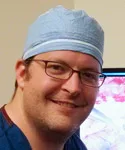What have graduates of the University of Wisconsin School of Medicine and Public Health been up to lately? Three medical school alumni who are neurological surgeons share their stories.
Christopher Baggott, MD ’10

I am a fifth-year neurosurgery resident at University of Wisconsin Hospital and Clinics, where I am doing a one-year neuroendovascular fellowship enfolded into my residency. I care for adults and children who have surgical problems of the brain, spine and peripheral nerves.
Recently, I have been focusing on surgery through the blood vessels to treat strokes, aneurysms and vascular malformations.
While nearly every case seems memorable, the surgeries that stand out the most show me anatomy I never thought I would see. For instance, when working endoscopically through the nose, we drilled laterally to the pterygopalatine fossa, which is difficult to reach. In that moment, I entirely understood the anatomy of that little bony space. It felt like a real accomplishment.
This field unites two almost opposing forces: the astonishingly beautiful anatomy of the nervous system and the intense human suffering that comes when the system malfunctions. My job, both in its good and its bad, amplifies my life; I wouldn’t trade this for anything.
I am a resident member of the Congress of Neurological Surgeons and the American Association of Neurological Surgeons, and also a research fellow for the National Institutes of Health StrokeNet.
In medical school, I did not know what I wanted to do, but I realized what I wanted to learn. Neuroanatomy never felt like a chore; it was more of an adventure. The microcosm of neurosurgery has become the central focus in my life.
The field comes with good and bad, joy and pain, and all the rest that you can imagine. However, I can’t imagine my life without it. I more or less wandered into neurosurgery on a whim, and I have received more from the field than I could have ever asked for. My advice for anyone interested in this specialty? Don’t be intimidated.
Jamie J. Van Gompel, MD ’05

I am an assistant professor in neurosurgery and otolaryngology at Mayo Clinic in Rochester, Minnesota.
In my cranial surgery practice, my primary focus is open and endoscopic skull base, and I do some deep-brain stimulation (DBS), all as part of a multidisciplinary team. I have an active epilepsy practice which crosses over with DBS, and we have a trial of anterior nuclear stimulation combined with hippocampal recording.
As a medical student, I recall a 4-year-old patient presenting with bilateral sixth nerve palsies. The physicians — Drs. Bermans Iskandar (pediatric neurosurgery) and Behnam Badie (adult neuro-oncology) — expertly evaluated the patient and delivered an excellent but complex multidisciplinary treatment plan for a difficult clival chordoma. The patient did very well. Prior to this, I had been interested in a different field of medicine, but watching this case evolve — with the beautiful anatomy and challenging treatment — got me hooked into neurosurgery.
I took a break and did a Howard Hughes fellowship with Dr. Herbert Chen in the Division of General Surgery. Ultimately, I committed to neurosurgery during my fourth year of medical school.
I did my residency at Mayo Clinic in Rochester and completed a fellowship in complex cranial and skull base surgery at the University of South Florida in Tampa Bay.
I believe I have the best job in the world. Although the hours are long and the work challenging, it is worth it. Neurosurgeons get to save lives regularly. The rewards are many, including the beautiful anatomy in skull base and seeing patients’ quality of life improve substantially with DBS. However, as one of my mentors, Dr. John Atkinson, explains, “In neurosurgery, the highs are so very high, and the lows can be so very low.” Those who choose this field need to be prepared for that contrast; it is not for the faint of heart.
Peter Rasmussen, MD ’91

Since completing my residency in the Department of Neurological Surgery at UW Hospital and Clinics, I have practiced at Cleveland Clinic. For the first two years, I did fellowships in cerebrovascular and endovascular neurosurgery, and I was invited to join the faculty. This is a wonderful place to practice, and we care for patients from all over the world who have a wide range of conditions.
My practice is exclusively cerebrovascular. Most of my patients have cerebral aneurysms and arteriovenous malformations, and a smaller percentage have cavernous malformations and spinal vascular lesions. Some are best approached with microsurgery, and others with endovascular techniques.
My most memorable patient was a 7-year-old girl who presented with lethargy caused by multiple cranial neuropathies, including a giant cavernous malformation of her pons. Her parents were devastated watching her slowly fade away. We resected the lesion, and in eight weeks she was back competing in ballet. That kind of success makes a career worthwhile.
I became interested in this field after rotating on the neurosurgery service with Dr. Greg Trost when I was a third-year medical student and he was the junior resident. I immediately found it very satisfying to treat major, life-threatening diseases.
Early in my career, I served as a member at large and vice chair of the Joint Section of Cerebrovascular Surgery. For the past five years, I have participated in the Society of Neurointerventional Surgery, and I am now its president. It has been an honor and privilege to help develop the specialty for the benefit of patients.
I believe there is no higher satisfaction than being trusted by a patient to operate on his or her brain. I cherish that privilege, and patients’ trust continually drives me toward excellence in delivering the best possible experience and outcome that I can for them.